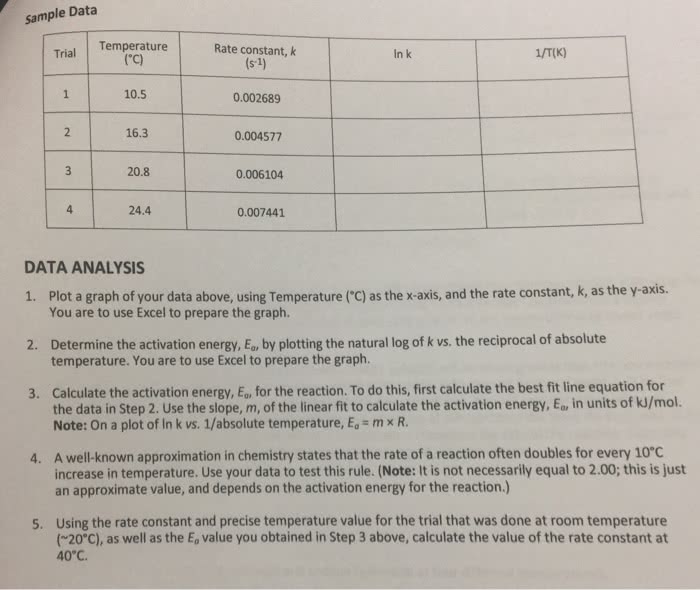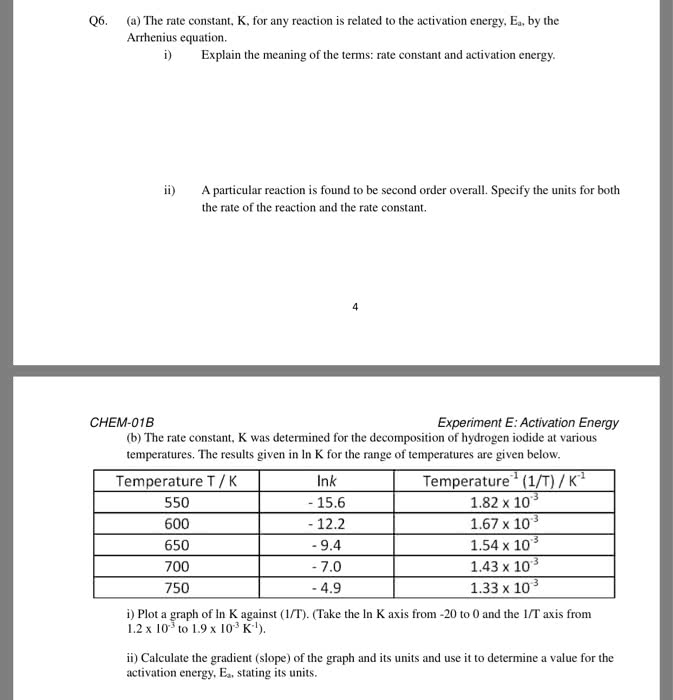Trial
Temperature
(oC)
Rate constant, k
(s-1)
1
21.6
- 8.99 x 10^-4
2
20.2
- 1.84 x 10^-3
3
15.9
- 3.75 x 10^-3
4
9.7
- 1.7 x 10^-3
DATA ANALYSIS
3. Calculate the activation energy, Ea, for the reaction. To do this, first perform a linear fit on the graph you created in Step 2 above. Use the slope, m, of the linear fit to calculate the activation energy, Ea, in units of kj/mol. Note: On a plot of ln k vs. 1/absolute temperature Ea= m x R.
4. A well-known approximation in chemistry states that the rate of a reaction often doubles for every 10oC increase in temperature. Use your data to test this rule. Calculate the ratio of the rate constant at ~20oC to the rate constant at ~10oC. Then calculate the ratio of the rate constant at ~25oC to the rate constant at ~15oC. How close were these values to a ratio of 2? (Note: It is not necessarily equal to 2.00; this is just an approximate value, and depends on the activation energy for the reaction.)
5. Using the rate constant and precise temperature value for the trial that was done at room temperature (~20+o+C), as well as the Ea value you obtained in Step 3 above, calculate what the rate constant would be at 40oC.
| Trial | Temperature (oC) | Rate constant, k (s-1) |
| 1 | 21.6 | - 8.99 x 10^-4 |
| 2 | 20.2 | - 1.84 x 10^-3 |
| 3 | 15.9 | - 3.75 x 10^-3 |
| 4 | 9.7 | - 1.7 x 10^-3 |
DATA ANALYSIS
3. Calculate the activation energy, Ea, for the reaction. To do this, first perform a linear fit on the graph you created in Step 2 above. Use the slope, m, of the linear fit to calculate the activation energy, Ea, in units of kj/mol. Note: On a plot of ln k vs. 1/absolute temperature Ea= m x R.
4. A well-known approximation in chemistry states that the rate of a reaction often doubles for every 10oC increase in temperature. Use your data to test this rule. Calculate the ratio of the rate constant at ~20oC to the rate constant at ~10oC. Then calculate the ratio of the rate constant at ~25oC to the rate constant at ~15oC. How close were these values to a ratio of 2? (Note: It is not necessarily equal to 2.00; this is just an approximate value, and depends on the activation energy for the reaction.)
5. Using the rate constant and precise temperature value for the trial that was done at room temperature (~20+o+C), as well as the Ea value you obtained in Step 3 above, calculate what the rate constant would be at 40oC.


